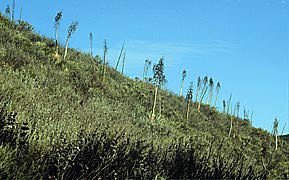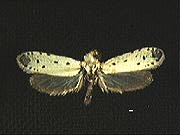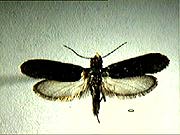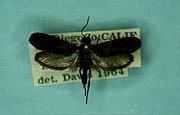Tegeticula maculata
Olle PellmyrAdult Characteristics
Subspecies maculata: Wing expanse 16-23 mm. Forewing white, with 2-12 black spots lining the edge of the apical portion of the wing, sometimes coalescing at the apex, and a prominent discal spot. Hindwings medium gray, lightly scaled.
Subspecies extranea: Wing expanse 14-19 mm. Forewing completely black. Hindwings of the same color, but more thinly scaled.
Comparison with Similar Species
The two subspecies are very distinctive from each other and from other species. The darker subspecies could conceivably be mistaken for T. synthetica on Y. brevifolia, but its abdomen is not dorsally flattened as in synthetica, and the female does not have a triangualar seventh tergite. Examination of the genitalia provides definitive identification for both sexes.
Host, Oviposition, and Larval Feeding Habits
Feeds exclusively on Yucca (Hesperoyucca) whipplei (Agavaceae). The female oviposits into flowers, or rarely fruits, and the larva feeds on developing seeds. Pupation occurs in a cocoon in the soil. Adults are largely diurnal.
Geographic Distribution
The host occurs in central-southern cismontane California, in Sierra Nevada north to Fresno Co, in northwestern Arizona (USA), and in Baja California Norte (Mexico) to the Vizcaino region (Powell and Mackie 1966). The subspecies T. m. maculata occurs in the northern portion of the host range, coming into contact with the southern subspecies T. m. extranea in the transverse ranges north of Los Angeles.
Habitat
In coastal chaparral and montane dry shrubby grassland with Yucca whipplei (Agavaceae).


Typical habitat with old, fruiting Y. whipplei; Santa Barbara Co., California.
Ecological Notes
Tegeticula maculata has been extensively studied by lepidopterists and ecologists; Powell and Mackie (1966) provided detailed biological information, Aker (1982) and Aker and Udovic (1982) studied oviposition behavior, and Richter and Weis (1995) studied the role of selective fruit abortion in maintaining the moth-host mutualism.
Phylogenetic Notes
Tegeticula m. maculata and T.t.extranea were originally described as separate species. Davis (1967) gave them subspecies rank, with the caveat that further study may support status as separate sister species. Pellmyr et al. (1996) found substantial sequence divergence between the two taxa, lending support for such a reconsideration.
References
Aker, C.L. 1982. Spatial and temporal dispersion patterns of pollinators and their relationship to the flowering strategy of Yucca whipplei (Agavaceae). Oecologia 54:243-252.
Aker, C.L. and D. Udovic. 1981. Oviposition and pollination behavior of the yucca moth, Tegeticula maculata (Lepidoptera: Prodoxidae), and its relation to the reproductive biology of Yucca whipplei (Agavaceae). Oecologia 49:96-101.
Davis, D.R. 1967. A revision of the moths of the subfamily Prodoxinae (Lepidoptera: Incurvariidae). U.S. Nat. Hist. Mus., Bull. 255:1-170.
Pellmyr, O., J. Leebens-Mack & C.J. Huth. 1996a. Non-mutualistic yucca moths and their evolutionary consequences. Nature 380:155-156.
Powell, J.A. and R.A. Mackie. 1966. Biological interrelationships of moths and Yucca whipplei. Univ. Calif. Publ. Entomol. 42:1-59.
Richter, K.S. and A.E. Weis. 1995. Differential abortion in the yucca. Nature 376:557-558.
Title Illustrations

| Scientific Name | Tegeticula maculata maculata |
|---|---|
| Specimen Condition | Dead Specimen |
| Image Use |
 This media file is licensed under the Creative Commons Attribution-NonCommercial License - Version 3.0. This media file is licensed under the Creative Commons Attribution-NonCommercial License - Version 3.0.
|
| Copyright |
© 1996
Olle Pellmyr

|
| Scientific Name | Tegeticula maculata extranea |
|---|---|
| Location | Tulare Co., California, USA |
| Specimen Condition | Dead Specimen |
| Image Use |
 This media file is licensed under the Creative Commons Attribution-NonCommercial License - Version 3.0. This media file is licensed under the Creative Commons Attribution-NonCommercial License - Version 3.0.
|
| Copyright |
© 1996
Olle Pellmyr

|
| Scientific Name | Tegeticula maculata extranea |
|---|---|
| Location | Riverside and San Diego Counties, California |
| Specimen Condition | Dead Specimen |
| Image Use |
 This media file is licensed under the Creative Commons Attribution-NonCommercial License - Version 3.0. This media file is licensed under the Creative Commons Attribution-NonCommercial License - Version 3.0.
|
| Copyright |
© 1996
Olle Pellmyr

|
About This Page
Olle Pellmyr

University of Idaho, Moscow, Idaho, USA
Page copyright © 1996 Olle Pellmyr
 Page: Tree of Life
Tegeticula maculata .
Authored by
Olle Pellmyr.
The TEXT of this page is licensed under the
Creative Commons Attribution-NonCommercial License - Version 3.0. Note that images and other media
featured on this page are each governed by their own license, and they may or may not be available
for reuse. Click on an image or a media link to access the media data window, which provides the
relevant licensing information. For the general terms and conditions of ToL material reuse and
redistribution, please see the Tree of Life Copyright
Policies.
Page: Tree of Life
Tegeticula maculata .
Authored by
Olle Pellmyr.
The TEXT of this page is licensed under the
Creative Commons Attribution-NonCommercial License - Version 3.0. Note that images and other media
featured on this page are each governed by their own license, and they may or may not be available
for reuse. Click on an image or a media link to access the media data window, which provides the
relevant licensing information. For the general terms and conditions of ToL material reuse and
redistribution, please see the Tree of Life Copyright
Policies.
Citing this page:
Pellmyr, Olle. 1996. Tegeticula maculata . Version 01 January 1996 (under construction). http://tolweb.org/Tegeticula_maculata/12450/1996.01.01 in The Tree of Life Web Project, http://tolweb.org/












 Go to quick links
Go to quick search
Go to navigation for this section of the ToL site
Go to detailed links for the ToL site
Go to quick links
Go to quick search
Go to navigation for this section of the ToL site
Go to detailed links for the ToL site